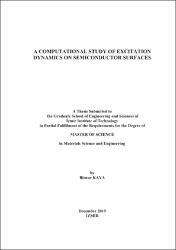Please use this identifier to cite or link to this item:
https://hdl.handle.net/11147/9653Full metadata record
| DC Field | Value | Language |
|---|---|---|
| dc.contributor.advisor | Sevinçli, Haldun | |
| dc.contributor.advisor | Özçelik, Serdar | |
| dc.contributor.author | Kaya, Birnur | - |
| dc.date.accessioned | 2020-09-04T10:55:52Z | |
| dc.date.available | 2020-09-04T10:55:52Z | |
| dc.date.issued | 2019-12 | en_US |
| dc.identifier.citation | Kaya, B. (2019). A computational study of excitation dynamics on semiconductor surfaces. Unpublished master's thesis, İzmir Institute of Technology, İzmir, Turkey | en_US |
| dc.identifier.uri | https://hdl.handle.net/11147/9653 | |
| dc.description | Thesis (Master)--Izmir Institute of Technology, Materials Science and Engineering, Izmir, 2019 | en_US |
| dc.description | Includes bibliographical references (leaves: 64-69) | en_US |
| dc.description | Text in English; Abstract: Turkish and English | en_US |
| dc.description.abstract | Recent experimental studies have shown that collodial quantum dots can be produced in large quantities and their optical properties can be tailored by controlling their composition, size and surface characteristics. Motivated by these studies, this thesis is devoted to the investigation of excitation dynamics on semiconductor surfaces, which are passivated with organic molecules. First, constructing a simplified model, excitation dynamics is investigated by computing time dependent occupations of frontier molecular orbitals for various scenarios regarding the values for the energy gap between the highest occupied and the lowest unoccupied molecular orbitals (HOMO and LUMO), as well as the coupling strengths. Second, the model is enhanced to address realistic systems. Passivation of ZnS surface with oleic acid (OA) is modeled using density functional theory based tight binding (DFTB) simulations. Extracting the Hamiltonian and overlap matrices, excitation dynamics is studied for Zn rich and S rich surfaces and different coverage ratios of surfaces. The excitation dynamics is compared and contrasted against the simplified model. Characteristic features are identified and typical decay rates are calculated for various molecular configurations. In addition to these, X-Ray diffraction spectra of quaternary ZnCdSSe nanoalloys have been investigated. | en_US |
| dc.description.abstract | Son deneysel çalışmalar kolloidal kuantum noktalarının büyük miktarlarda üretilebileceğini ve optik özelliklerinin kompozisyonlarını, boyutlarını ve yüzey özelliklerini kontrol ederek uyarlanabileceğini göstermiştir. Bu çalışmaların motive ettiği bu tez, organik moleküllerle pasife edilmiş yarı iletken yüzeylerdeki uyarılma dinamiklerini araştırmaya adanmıştır. İlk olarak, basitleştirilmiş bir modelin oluşturulmasıyla uyarılma dinamikleri, etkileşim gücünün yanı sıra, en yüksek dolu ve en düşük boş moleküler orbitaller (HOMO ve LUMO) arasındaki enerji boşluğu değerlerine ilişkin çeşitli senaryolar için öncü moleküler orbitallerin zamana bağlı doluluk oranları hesaplanarak incelenmiştir. İkinci olarak, bu model gerçekçi sistemleri ele almak için geliştirilmiştir. ZnS yüzeyinin oleik asit (OA) ile pasive edilmesi yoğunluk fonksiyoneli teorisine dayanan sıkı bağlanma simülasyonları kullanılarak modellenmiştir. Hamiltonyen ve örtüşme matrisleri elde edilerek Zn ve S bakımından zengin yüzeylerde ve yüzeylerin farklı kaplama oranlarında uyarılma dinamikleri incelenmiştir. Uyarılma dinamikleri basitleştirilmiş modelle karşılaştırılmıştır. Karakteristik özellikler tanımlanmış ve çeşitli moleküler konfigürasyonlar için tipik bozulma oranları hesaplanmıştır. Bunlara ek olarak, kuaterner ZnCdSSe nano alaşımlarının X-ışını kırınım spektrumları incelenmiştir. | en_US |
| dc.description.sponsorship | TUBITAK (115F616) | en_US |
| dc.format.extent | xii, 73 leaves | en_US |
| dc.language.iso | en | en_US |
| dc.publisher | Izmir Institute of Technology | en_US |
| dc.rights | info:eu-repo/semantics/openAccess | en_US |
| dc.subject | Quantum dots | en_US |
| dc.subject | Semiconductor surfaces | en_US |
| dc.subject | Density Functional Theory | en_US |
| dc.title | A computational study of excitation dynamics on semiconductor surfaces | en_US |
| dc.title.alternative | Yarı iletken yüzeylerde uyarılma dinamiklerinin hesaplamasal olarak çalışılması | en_US |
| dc.type | Master Thesis | en_US |
| dc.institutionauthor | Kaya, Birnur | - |
| dc.department | Thesis (Master)--İzmir Institute of Technology, Materials Science and Engineering | en_US |
| dc.relation.tubitak | info:eu-repo/grantAgreement/TUBITAK/MFAG/115F616 | |
| dc.relation.publicationcategory | Tez | en_US |
| item.languageiso639-1 | en | - |
| item.fulltext | With Fulltext | - |
| item.openairecristype | http://purl.org/coar/resource_type/c_18cf | - |
| item.openairetype | Master Thesis | - |
| item.grantfulltext | open | - |
| item.cerifentitytype | Publications | - |
| Appears in Collections: | Master Degree / Yüksek Lisans Tezleri | |
Files in This Item:
| File | Description | Size | Format | |
|---|---|---|---|---|
| 10166685.pdf | MasterThesis | 12.71 MB | Adobe PDF |  View/Open |
CORE Recommender
Page view(s)
178
checked on Jul 22, 2024
Download(s)
118
checked on Jul 22, 2024
Google ScholarTM
Check
Items in GCRIS Repository are protected by copyright, with all rights reserved, unless otherwise indicated.